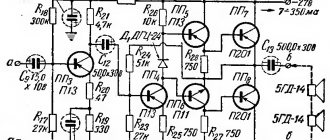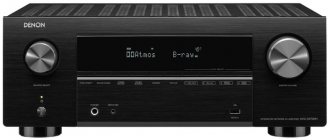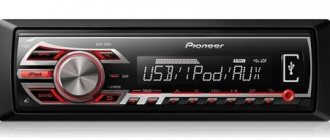Pioneer representatives have repeatedly stated that the company's main activity is automotive electronics. This unspokenly meant: “don’t judge us harshly for the quality of other equipment.” I dare to reproach the Japanese “pioneers” for false modesty: impressed by listening to the VSX-924 AV receiver, our experts nominated it for EISA, the most prestigious AV award in the Old World, and colleagues from other European publications could not resist the pressure of our arguments : The device received the title “Best Product 2014-2015” in the “Home Theater Receiver” category. If the mid-level model is so good, what will the representative of the flagship line be like?
Front and rear
The first impression is maximum solidity, minimum frivolity. The height of the receiver reaches no less than 185 mm; perfect symmetry reigns on the facade: the rotary handles of the input selector and volume control have the same diameter; next to them there are two indicators - the Advanced MCACC equalization mode, turning off the display and activating HDMI/working with an iOS gadget, respectively.
Advantages:
— 9.2-channel path
- Dolby Atmos support
— Built-in Bluetooth module
Flaws:
— Poor ergonomics of the remote control
The main work area is hidden behind a folding flap. Here there are access keys for adjusting audio and video parameters, working in zones 2 and 3, setting up a tuner, etc., as well as an HDMI input with support for the MHL interface.
Nearby are a USB port, a 6.3 mm telephone output and a mini-jack for the measuring microphone of the proprietary MCACC auto-calibration system. At the back there are seven more inputs and three (!) HDMI outputs, a LAN socket, a USB B port (for working with a computer/server) and a USB A for a wireless LAN converter (included in the package).
AV receiver Pioneer SC-LX88. The hinged door, which hides the main switching and control area, eloquently indicates that the receiver belongs to business-class equipment.
There are also two component video inputs and an output; a pair of coaxial and optical digital audio inputs, an optical output, many analog audio inputs (including Phono) plus multi-channel 7.1 input and 11.2 output. Among the service ports, we note two 12 V relay signal outputs, an output and two inputs for an external IR sensor, plus an RS-232 interface socket.
Atmospheric expansion
AV receiver Pioneer SC-LX88 Price - RUB 122,990.
Such a significant expansion of functions as now has not been seen in top-tier Pioneer receivers for several years. From now on they support a completely new standard for multi-channel audio - Dolby Atmos
Over the past year, the topic of Dolby Atmos has filled all discussions of multichannel audio at various conferences, presentations and forums. It was connected, first of all, with the advent of the first cinemas and films in this unique format. Our compatriots, who visited the first cinema halls equipped with such a system, were also imbued with it - demonstration videos and films in this format, it seems, have not yet left anyone indifferent. Indeed, additional speakers on the ceiling created the effect of a barrage of sounds enveloping from all sides. But in demonstrations of home systems with Dolby Atmos, the effect remained not so impressive until recently. The fact is that until October 2014, all receivers with such decoders only emulated sound effects for the upper channels. They, in fact, had nothing left to do, since discs with Dolby Atmos tracks simply did not exist yet. And there were surprisingly few receivers themselves that supported the new surround sound format - most companies equipped only flagship models with the appropriate decoders. The exception was Pioneer, which presented a whole series of AV receivers with the LX index, which have a Dolby Atmos decoder. And now, when the first discs with such a track appeared on sale, we could not deny ourselves the pleasure of personally seeing the benefits of new-generation multi-channel sound. And for testing we chose, of course, the most advanced, flagship model of the company - Pioneer SC-LX88.
So far, only two films have been released with tracks in Dolby Atmos format: the fourth part of “Transformers,” called “Age of Extinction,” and “Teenage Mutant Ninja Turtles.” Immediately after the New Year, a special edition of the film “Gravity” is expected to appear with such a track, which will certainly become a hit. Preface to the questions, let’s say right away that so far only two films have been released with tracks in Dolby Atmos format: the fourth part of “Transformers”, called “Age of Extinction”, and “Teenage Mutant Ninja Turtles”. Not everyone will be thrilled with this, although the sound on these discs is amazing. But there is good news: right after the New Year, a special edition of the film “Gravity” will be released with such a track, which will certainly become a hit. You don't need a special player for these discs—you just need a relatively new Blu-ray player that supports Dolby TrueHD, because the data for the Dolby Atmos height channels is encrypted within the Dolby TrueHD stream. These are what the new generation receivers decode.
By the way, there will be three such models in the Pioneer line, which literally and figuratively constitute the elite of the company’s multi-channel equipment: Pioneer SC-LX88, Pioneer SC-LX78 and Pioneer SC-LX58. In the American market, their analogues have the Elite prefix in their names. It's a pity that the company doesn't use it in Europe. However, this new series is interesting not by its name, but by its capabilities, which we will dwell on in more detail.
Externally, all three models are identical to the receivers from last year’s line. They are distinguished only by a slightly modified Air Studios logo. Otherwise, in appearance they are twin brothers. Whether this is good or bad is up to you to judge, but we like this kind of conservatism. The design is classic, absolutely verified, and changing anything in it will only spoil it.
On the rear panel, the acoustic terminals and line outputs are grouped differently, and there are more of them. At first you are frankly lost, because all the models in this series are positioned as 9.2-channel, and the number of outputs corresponds to the new scheme adopted specifically for Dolby Atmos - 7.2.4. What this means in effect is that if you're using only the built-in amplifiers, you'll only be able to choose between a 5.2 connection with four channels for the height speakers and a 7.2 connection with two channels for the height speakers. When using external power amplifiers, it will be possible to use all thirteen channels served by the Dolby Atmos decoder. It sounds complicated, but this is the price to pay for the immersion effect - based on experience, other methods can only achieve it using reference test recordings, which you won’t find on regular discs during the day.
Connecting everything using a full 13-channel circuit is not an easy task. And setting it up manually using the system menu with checking phase, adjusting delays, equalizer and other things is extremely complicated. The proprietary MCACC automatic calibration system not only helps, but literally saves the day. In case of an error, you don’t even need to reconnect the channels - their purpose can be changed directly during the setup process. Channel-by-channel equalization is performed very correctly - the sound does not become dull or compressed.
Connecting sources, on the contrary, does not cause any problems. Eight HDMI inputs are available for receiving video, one of which is located on the front panel and supports connecting smartphones and tablets directly using the MHL protocol, and at the same time recharging them. There are no restrictions on the resolution and quality of the video signal. Neither the specifications nor the instructions contain precise information about the version of the HDMI ports, but compatibility with the highest possible signal type today, 4K with 4:4:4 color clarity and 24-bit resolution, hints that the receiver supports the HDMI v2.0 standard. Moreover, it not only passes such a signal through itself, but can also scale, that is, increase the resolution of the incoming video to 4K. However, this function is available not only in LX series models, but also in Pioneer receivers, which occupy a middle position in the company’s line of AV components this year. They are also united by the ability to play high-resolution audio media files up to DSD from DLNA servers and computers over the network, as well as play multi-channel recordings in FLAC files.
What distinguishes the flagship Pioneer SC-LX88 model is the presence of an asynchronous USB DAC with a USB type B input for decoding an audio stream directly from a computer. Considering the outstanding audio capabilities of the device, the presence of such a function in it does not seem superfluous.
However, most potential buyers of the Pioneer SC-LX88 will use it specifically as a home theater component. And in this capacity he performs simply magnificently. Pioneer receivers have previously been famous as ideal devices for cinema due to the use of perhaps the best processors for decoding audio tracks. However, this time testing made a completely new impression on us. We are, of course, talking about watching movies with a Dolby Atmos track. We never regretted the fact that we had to tinker almost all day with installing four additional speakers under the ceiling.
Testing made a completely new impression on us.
We are, of course, talking about watching movies with a Dolby Atmos track. The listening effect could only be compared with the very first experience of testing a multi-channel system. In tense moments, I involuntarily wanted to turn my head towards the source of the sound. Only this time not back, but upward, where every now and then something was beating, exploding and grinding, frightening with the unusual localization of the effects. The listening effect could only be compared with the very first experience of testing a multi-channel system on a DTS demo disc. Every now and then my hair stood on end, my skin was covered with goosebumps, and in tense moments I involuntarily wanted to turn my head towards the source of the sound. Only this time not back, but upward, where every now and then something was beating, exploding and grinding, frightening with the unusual localization of the effects. When listening to regular multi-channel tracks in DTS-HD Master Audio and Dolby TrueHD formats with Dolby Atmos emulation, of course, the impressions were not so strong due to some blurriness of the effects. However, turning off the upper channels and tuning to the standard configuration revealed a certain lack of volume - there was no sound dome that covered like a lid when viewed from above. Overall, we had an unforgettable experience! So, if you are building a cinema hall and you have the opportunity to install overhead speakers, then it’s worth buying just such a device - you won’t regret it!
Double chassis
For several years now, Pioneer's flagship receivers have been built with an isolated double chassis using the proprietary 3-D Space Frame design. The body of our ward is designed according to its newest version, which is called Advanced Direct Construction. As a result, the vibrations of the network transformer are not transmitted to noise-sensitive digital signal processing circuits, and for this model this is extremely important: the total power of the 9-channel amplifier path is 850 W (8 Ohms).
The amplifiers operate in class D (Direct Energy HD modules are used) and, according to the developers, consume 44% less electricity than class A-B devices. The layout of printed circuit boards is such that the signal paths are the shortest. All of the above, coupled with audiophile-quality components and audio tuning carried out by George Martin's legendary Air Studios, allows the device to claim the title of the heart of a high-end home entertainment system.
Rear panel of the Pioneer SC-LX88 AV receiver. There are three HDMI outputs, a phono input and an RS-232C connector, as well as a USB B port for connecting a computer. A through channel can be organized not only using a linear signal, but also using an optical signal. Even the component video inputs are not forgotten
Texas Instruments Aureus TMS320DA808 chips that meet all the latest requirements are used as a DSP processor; the onboard DAC is based on a high-quality ESS Saber chip operating in 32-bit mode. The stereo signal is processed using the proprietary Hi-Bit 32 algorithm. PQLS technology ensures reception of an audio stream with virtually no jitter from a compatible source.
It is especially worth noting the multi-zone capabilities of the receiver. You can supply not only linear stereo and composite or (to one of the zones) component video to the second and third rooms, but also a high-level stereo signal, and an independent HDMI signal from the third HDMI output to a separate HD zone.
The AXF7031 wireless LAN converter comes standard with the Pioneer SC-LX88 AV receiver
When testing the previous SC-LX87 model, we were disappointed to note that it only provided a Bluetooth interface using an optional adapter. This device eliminates this drawback thanks to the built-in Bluetooth module, compatible with the aptX codec.
Welcome, welcome
The receiver accepts AirPlay; in streaming mode via DLNA, audio files are read from a computer or NAS server, incl. AAC, WMA and DSD, as well as FLAC and WAV (up to 32/192) plus AIFF (up to 24/192), as well as multi-channel WAV and FLAC recordings (gapless playback supported). Moreover, a new version of the software has appeared on the company’s website, providing the ability to decode Dolby Atmos soundtracks.
The standard video processor is capable of increasing the resolution of the input signal to 4K/60p (4:4:4, 24 bit). You can adjust video parameters according to the type of connected monitor, use two noise reduction systems, and improve low bitrate signals using Stream Smoother technology. There is also an audio scaler (Audio Scaler), capable of bringing the stream from a CD to the level of 32 bits/192 kHz.
Calibration microphone included with the Pioneer SC-LX88 AV receiver
When connected to the Internet, access to many radio stations is provided through the vTuner service. The iControlAV5 control application not only allows you to control almost all functions of the receiver from a smartphone or tablet computer (Apple or Android), but also provides access to music libraries stored on your mobile device, as well as the ability to create playlists from them. Air Jam is supported, a Bluetooth application that allows owners of several mobile gadgets to create a common playlist.
Blu-ray station wagon Pioneer BDP-LX88-K
The higher the class of equipment, the less often it is updated, and this is completely natural, since the development of top-end devices can take more than one year. For example, the previous older model of the Pioneer BDP-LX91 Blu-ray player was released in 2008, and the current flagship BDP-LX88 went on sale in January 2015, that is, 7 years later. Even a quick comparison of the two players allows us to conclude that we are not talking about cosmetic changes, but rather significant differences.
The first thing that immediately catches your eye is a significant change in price: the new model is much cheaper than the previous one - naturally, in foreign currency. In rubles it turns out to be 10 thousand more expensive, but the exchange rate has changed a lot since then. It goes without saying that the question arises: how was the cost reduction achieved? We have long stopped believing in the miracles of progress that make it possible to reduce the price without simplifying the design. Indeed, the LX88 lost some of the capabilities of its predecessor, but this did not happen as a result of “budget sequestration,” but in a completely natural way - this is exactly how human ancestors got rid of their tail in their time. So, the device is freed from analog video outputs - they really are not needed now: even if you still have an ancient TV or projector that only has such inputs, you can get by with the cheapest player. Analog multi-channel audio outputs have also disappeared - I think the need for them has also disappeared. The device is intended for a serious home theater, which must certainly have an appropriate class receiver or even an external AV processor. Moreover, the LX88 is equipped with two HDMI outputs, which allows you to separately output digital video and audio streams, thereby achieving better quality. If the system uses a receiver from Pioneer with support for proprietary PQLS technology (Precision Quartz Lock System), the accuracy of information transmission increases even more due to the elimination of jitter.
Demanding music lovers are not forgotten either: the device not only retained stereo analogue sound outputs, but also received balanced ones on XLR connectors, which the LX91 did not have. Another interesting innovation is a single RCA connector, designated Zero Signal. It must be connected with an RCA - RCA cable (the cheapest one will do) with any free analog input connector of the amplifier or receiver - according to the manufacturer's documentation, this will allow you to equalize the potentials of the zero (ground) buses* of the two devices, reduce interference and improve the compatibility of the two devices.
*Potential differences on the zero buses of two devices may occur if the “ground” contact in the connectors is isolated from the housing.
Naturally, the design has changed - it has become more laconic, solid and modern. The obsessive gloss has gone from the front panel. The fashion for thin cases has passed, so it is no longer necessary to visually divide the device into two parts due to the recess along the front panel. In addition, the new model has a case height of 13 mm less, and it looks quite harmonious.
The transition to a modern element base made it possible to abandon forced cooling - the device became completely silent.
The result of all these changes was a slight reduction in the weight of the player - by only 900 g. However, this “weight loss” did not affect the multi-layer anti-vibration chassis - the design remained just as thoughtful and serious. Moreover, there have been some important changes.
Lx88 lost some of the capabilities of its predecessor, but this did not happen as a result of “budget sequestration”, but in a completely natural way - this is exactly how human ancestors got rid of their tail in their time.
Rich inner world
The internal space of the case is divided into three isolated compartments (digital path, analog and power supply), and all parts of the circuit that work with high-frequency signals received their own “personal” screens - the LX91 did not have them. The open toroidal transformer of the power supply has been replaced with an W-shaped one in a copper casing - for Russia, where there is often an increased level of the DC component in the supply voltage, this is a great benefit.
The multilayer chassis is 3 mm thick, the side and rear walls are made of 1 mm thick steel, in addition, aluminum linings are installed on the side surfaces, however, the LX91 also had them. The drive is branded with an original damper that makes the tray's movements almost silent, and a pleasant velvety interior finish.
As for the circuitry of the LX88, somewhat less is known about it than about the design of its predecessor. Thus, there is no official information about the decoder chip and other integrated circuits used in the video path. It is only reported that the Precise Pixel Driver module, made on a separate chip (according to unofficial data, this is a Marvell DE2750 QDeo processor), scales all input video signals to 1080/24p or 60p format, while improving the elaboration of the smallest details, increasing the video bit depth from 8 to 12 bit. If the output requires UHD resolution, the latest 4K Reference Converter processor (a large chip installed near HDMI) comes into play - it increases the video resolution to 2160/24p, 60p. It goes without saying that the HDMI interface complies with the 2.0 specification, that is, it is capable of outputting video in 4K with a refresh rate of up to 60 Hz.
The transition to a modern element base made it possible to abandon forced cooling - the device became completely silent.
More is known about the analog path. Thus, the DAC is built on one 8-channel ESS Sabre32 ES9018 chip, and 4 converters are used for each of the two channels, which made it possible to build a truly balanced path and implement differential switching, which makes conversion to analog more accurate, expands the dynamic range and reduces noise . Let me remind you that the DAC model LX91 was built on eight 2-channel Wolfson WM8740 microcircuits. That is, the abandonment of multi-channel output made it possible not only to obtain a balanced analog audio output, but also to get by with one chip instead of eight. In addition, replacing Wolfson with ESS made it possible to directly decode DSD streams without first converting to PCM. A precision clock oscillator in the DAC is reported to be needed to eliminate jitter, but more detailed information about its design is not available. But it is known that signal circuits use components specially selected for sound, in particular, capacitors. In general, everything is as befits a device of the highest class.
Samurai asceticism
The graphical interface is extremely ascetic: white text on a black background. The only decoration is the pictures that appear on the right when selecting some menu items. However, Pioneer has used this design in all Blu-ray players, including the most affordable models, and for quite a long time. I think Pioneer has had a penchant for deep black since the days of KURO. By the way, such a dark design allows you to save energy when using plasma panels and LED TVs with matrix backlighting.
If there is no optical disc in the drive, the player remains calm, showing the Pioneer logo on a black background - you need to press the Home button on the remote control (with a house icon) - a menu will open through which you can enter the settings section or select the source of information - a USB drive ( the corresponding item appears after connecting a flash drive or HDD) or network resources that support the DLNA protocol. Unlike my old BDP-150, which requires some patience not only when navigating the network, but also selecting files on an external HDD, everything on the LX88 works without delay and clearly.
The optical drive also works quite quickly: the Blu-ray loading time falls within the range of 25-30 seconds, depending on the generation of protection. As you can see, if for the sake of noiselessness we had to sacrifice speed, it was very little.
A paradise for perfectionists
Traditionally for Pioneer, image and sound parameters can be adjusted in the most thorough manner, and access to the settings is provided by separate buttons on the remote control (backlit, by the way). By pressing the AUDIO P. key, we display a compact menu that allows us to control digital processing and some operating modes of the DAC. In particular, we can deactivate the Hi-bit32 processor (active by default) - it increases the bit depth of digital audio streams to 32 bits. It is possible to disable sampling frequency conversion or change its multiplicity (x2, x4), as well as select the digital filter characteristic (Slow/Sharp, the second position by default). Auto Sound Retriever processing (off by default) is designed to improve the sound of lossy compressed music files. Two more items relate to home cinema: Audio Sync (automatic or manual synchronization of video and audio track) and Audio Delay (related to the previous switch and allows you to manually set the audio delay time relative to the video).
The key on the remote control, designated as VIDEO P., displays a menu for setting image parameters, where you can select a ready-made preset (each of them is designed to adapt the picture to a specific type of display), create up to three of your own, or disable any video processing (Reference preset ). There are also controls for motion processing systems (Progressive Motion) and progressive scanning (Pure Cinema), as well as a noise reduction complex (Stream Smoother) and Film Grain processing (imitation of film grain). What is especially valuable is the ability to fine-tune noise reduction - separately for four types of noise.
In fact, when playing a high-quality and well-recorded film on Blu-ray, no manipulations with settings and processing are required - you can safely select the Reference preset to see the picture exactly as the director and cameraman intended it. Provided, of course, that your TV or projector is high-end and correctly calibrated.
Disks, files and force majeure
Regional protection is active and corresponds to the markings on the rear panel: zone Blu-ray – C, for DVD-Video – 5. Cinavia technology is supported by the player. Blu-rays in ISO images and folders are not played, however, in the latter case you can enter the folder, find the STREAM subfolder in it, find the *.ts file with the movie in it and run it - it will play, but, of course , no menu. The drive does not recognize self-written SACDs on blanks. In general, the device fully complies with modern legislation. This can hardly be considered a disadvantage - you just need to take this into account when building your collection: if you want to use all the functions of Blu-ray, purchase legal discs in your zone and factory SACDs.
Another point to consider concerns networking: the only network protocol used by the player is DLNA, and if your NAS does not support it, you will not be able to read information from it.
If the sound seems too refined and smooth, you can disable upsampling by setting the multiplier to x1.
As I wrote above, the player’s DAC is capable of decoding DSD streams without prior conversion to PCM. Interestingly, this applies not only to SACD discs, but also to DFF/DSF files - their support is stated in the documentation. True, actual playback is not guaranteed (as well as some other types of files), as warned by the proprietary English-language booklet dedicated to the BDP-LX55/LX88 Blu-ray players: “Some file types included in the list of supported files may not be playable under certain conditions related to media file systems, server capabilities and network configuration.” And this is the honest truth: not a single player produced is capable of reliably reproducing absolutely everything that is encoded by the skillful hands of enthusiasts of free information exchange. It makes more sense to put your collection in order than to demand the impossible from your equipment.
Immersion in the material
Perhaps my following words may seem dubious to some, but their validity is confirmed by my many years of experience: all high-end Blu-ray players perform equally well. But - with an important caveat: if they themselves are correctly configured, and the monitor used is professionally calibrated. True, the quality of factory settings for equipment from different brands may differ, so players of different brands do not display the same “right out of the box”.
In this sense, the LX88 can serve as a model: its default settings are almost perfect. With the correctly selected preset (which matches the type of display), the picture turns out to be extremely believable, natural, deep, and at the same time very clear and clean, that is, free from noise. Of course, the quality of the video itself may not be perfect, so sometimes you may have to resort to some fine adjustments.
With music playback, things are a little more complicated.
To realize the full potential of the LX88, you need to switch the player's sound path to DIRECT mode (there are special buttons on the remote control and on the front panel) - the sound will be interrupted for a moment and the TV screen will go dark. The fluorescent display will continue to work, so to completely eliminate all potential sources of interference, you should turn it off using the DIMMER key on the remote control. However, I must note that the DIRECT mode does not provide very significant advantages - this suggests that the creators of the device managed to effectively decouple from each other all the blocks that can have mutual influence. However, since we were given the opportunity to turn off everything unnecessary, it would be a sin not to take advantage of it.
There are no difficulties with the discs - you slide in the tray with the media, and the process begins - you can control it from the remote control or using a proprietary mobile application. But to play music over the network, you will first have to turn on the TV, select the tracks you are interested in, start playing and only then switch to DIRECT mode. The proprietary mobile application is unlikely to help us in any way here, since it essentially only duplicates the main functions of the remote control - you cannot access the network storage device from it, select files and start playback. Well, the situation is typical: only very few network players, even high-end ones, have a full-fledged application for smartphones and tablets. And some have, say, an application for iOS, but nothing for Android. So you'll have to look for an alternative.
Of all the options I tested for Android, BubbleUPnP works best - the full-featured version is paid, but costs only 140 rubles. For iOS – PlugPlayer, it costs more – 279 rubles.
So, the application is installed, the digital filter characteristic is set to Slow**, the DIRECT mode is turned on - you can immerse yourself in the music.
**The default is Sharp - in this position the sound becomes, for my taste, a little colder and harsher, but if you like it, you can leave the default value.
The LX88 plays comfortably, softly, but without any “haze” - the stage is absolutely transparent, the images of the instruments are clearly focused, small details are conveyed, but without intrusiveness. Perhaps on some recordings one can notice the emphasized brightness of the percussion, but this can be easily eliminated by turning off the Hi-bit32 processing. If the sound seems too refined and smooth, you can disable upsampling by setting the multiplier to x1. But I must admit that in most cases the best result is given by the default value - x4. I usually try to turn off sample rate conversion, as it tends to clutter the scene, but in the LX88, this processing works surprisingly correctly and for the good. Rhythmic structures are accurately conveyed, the music is captivating and addictive... In fact, this is the most important thing, but the LX88 is also accurate, realistic and tonally neutral. It turns out that all these qualities are not at all opposite and can be harmoniously combined in one device.
And what’s especially nice is that it is characterized by an extremely attractive quality/price ratio. Pioneer managed to make the new flagship Blu-ray player not only more accessible than its predecessor, but also at the same time expand its functionality, reducing only the outdated interfaces. This is an honest upper class - without additional payment for brand promotion.
PLEASED
Exemplary picture and sound quality. Advanced settings for quality parameters, the ability to disable digital processing. Solid design and very good execution.
DISAPPOINTED
Limited functionality of the mobile application. No digital inputs
Pioneer BDP - LX 88- K
Manufacturer: Pioneer Corporation (Japan)
Pioneer Russia
Disc formats: BD-Video, Blu-ray 3D, DVD-Video, DVD-Audio, AVCHD, AVCREC, SACD, CD, HDCD, Kodak Picture CD, CD-R/RW, DVD±R/RW, DVD±R DL , BD-R/RE || File formats: 3GP, AVI, DivX plus HD, FLV, MKV, MP4, MPG, WMV, AAC, AIFF, ALAC, DSD (2.8 MHz), FLAC, mp3, Monkey's Audio, WAV, WMA, JPEG, GIF, MPO, PNG || Video processor: n.a. || 3D support: yes || 2D to 3D conversion: yes || 4K upscaling: yes || Audio DAC: ESS Sabre32 ES9018 II Supports PQLS technology yes II Network: Ethernet 10/100 Mbit|| Network protocol: DLNA || USB file systems: FAT16/FAT32, NTFS II Online services: YouTube, Picasa || Outputs: analog stereo (RCA), balanced (XLR); digital coaxial (RCA), optical (Toslink), HDMI 1.4a (x2) || USB A interface: x2 || Service connector: RS-232C || Mobile application: iControlAV5 (iOS, Android II Cooling: passive || Dimensions: 435 x 130 x 339 mm || Weight: 13.4 kg || Contents: user manual, power cord, remote control with batteries || Price: 109990 rub.
COMPONENTS
- TV Panasonic TX-PR50VT60
- Digital source: Windows computer with PCI interface ASUS Xonar Essence ST
- NETGEAR ReadyNAS Duo v2 Network Drives
- External DAC PS Audio PerfectWave DAC MkII
- Yamaha Soavo-1 speaker systems
- Integrated amplifier Musical Fidelity A5-INT
- Interconnect cables Musical Wire Cadence Signature RCA, acoustic cables Tchernov Cable Classic IC
- Digital cables: Black Rhodium HDMI JET 2.0 m, Audioquest Cinnamon USB 1.5 m, Furutech FX-Alpha-Ag coaxial 1 m
WATCHED
- Spider-Man Blu-ray BDMV. All zones
- "Casino Royale" Blu-ray. All zones
- "SWAT" Blu-ray. Zone B
- "Deja vu" Blu-ray. Zone A
- "Men in Black III 3D". Blu-ray ISO. All zones
- "Birdman", Blu-ray Remux (MKV)
- "HQV Test Benchmark", DVD-Video. All zones
- "Spider-Man", DVD-Video. All zones
- "Reservoir Dogs", DVD-Video. Zone 1
- A selection of MPEG2, MPEG4, H264 and VC1 video fragments in MKV, TS, M2TS and AVI file containers
LISTENED
- "McIntosh Spectacular Reference". FLAC 192 kHz/24 bit
- Larry Adler and Various, "The Glory of Gershwin". FLAC 44.1 kHz/16 bit
- "24-bits of Christmas 2014. With love from Linn." FLAC 192 kHz/24 bit
- Bill Frisell "Guitar in the Space Age!" CD Audio/FLAC 96 kHz/24 bit
- Grand Funk Railroad, "Closer To Home". FLAC 192 kHz/24 bit
- Deep Purple, "Machine Head". DVD-Audio/SACD/FLAC 96 kHz/24 bit/44.1 kHz/16 bit
- Carl Orff, “Carmina Burana” (Anima Eterna Brugge, Collegium Vocale Gent, Jos van Immerseel). FLAC 96 kHz/24 bit
- Diana Krall, "Wallflower". FLAC 48 kHz/24 bit
share
Tags: PioneerExpert's choicePersonal experience
Impression
Subjective testing revealed an unexpected advantage of the device: it can significantly improve the viewing experience of the so-called. DVDRips are highly compressed video files. In other words, the Stream Smoother mode turned out to be far from useless.
In terms of sound, the receiver is practically no different from the SC-LX87 - it is designed primarily for playing multi-channel soundtracks, it can easily drive six floor-standing speakers and a giant 3-way center channel speaker.
Standard remote control for Pioneer SC-LX88 AV receiver. You look at the remote control of the Pioneer receiver and once again you are perplexed: why are engineers afraid to make the buttons different in size or, at worst, in color?
The receiver handles high-resolution musical recordings that require ultra-precise transmission of nuances, as it seemed to us, too calmly. However, many people prefer this kind of rational sound, especially when listening to electronic music. If you are one of them, you want to recreate the so-called in the living room. club atmosphere, this device will come in handy.










